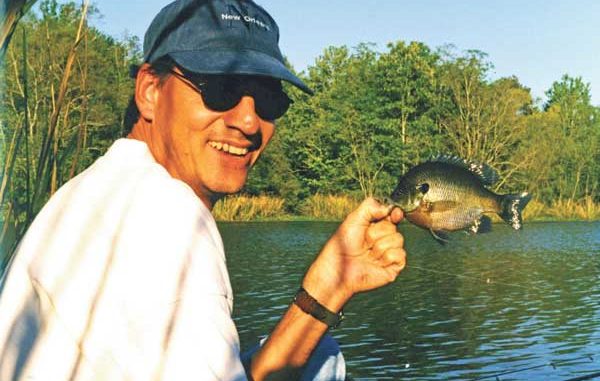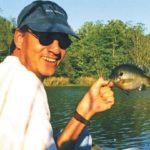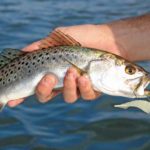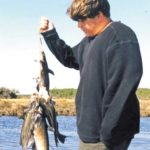
What’s biting this month on the Lower Pearl River? A better question is: What isn’t?
Howling winds forced us to cancel the Buras trip at 5 a.m. with a quick phone call. By 9 a.m., I was climbing the walls and also noticed that the grass needed mowing. Worse, Shirley also noticed that the grass needed mowing. I noticed her contemplating the issue from the front porch, and ran into the bathroom with my cell phone before she saw me.
“Let’s hit Pearl River,” I suggested to Pelayo over the phone. “Hell man, it’s close. It’s a beautiful day, winds won’t bother us much there. We can try for trout and reds in the brackish marsh down around where North Pass meets Little Lake right above the Rigolets.
“If nothing hits there, we can come up and do some panfishing — perch, yellow bass, catfish, maybe a couple of green trout. Relaxing fishing. Leisurely mid-day fishing. Heck we may not wear ’em out, but you know we’ll catch enough for a fish fry at Doc’s tonight. He said he already got the crawfish.”
“OK, OK,” he croaked. “We’ll take my boat … pick ya up in an hour.”
When fishing, we always want options. If the specks, for any of their number of unfathomable reasons, refuse to bite, then we’ll target the reds, puppy drum and sheepshead. And vice versa. This time of year, the lower Pearl River basin offers those options — plus the option for freshwater panfishing with just a slight haul upriver.
The public launch on the East Pearl at Highway 90 was crowded as we turned in to check things out. This late in the morning, we figured some boats would already be coming in, and employing proper interrogation techniques, we might obtain some good intel on the fishing prospects.
We parked and started walking toward the dock area as a spanking-new bay boat approached the dock at a speed that was not entirely wakeless. A very sightly blond in a red bikini top and sun hat was at the wheel, but had her head turned, waving to another gal at the controls of a bass boat that seemed to be aiming for the ramp itself, where a backed-down trailer seemed to be waiting. The bass boat approached at what also struck us as a pretty good clip.
“Connie!” squealed the one in the red bikini, while waving energetically. “How ya been, girl!”
“Hey! Look who it is!” Connie — also bikinied, but in blue — yelled back, waving. “Hiya, Cindy! Boy, y’all left the Jazz Fest too early! Shoulda stuck around and caught Buzzy doin’ the tequila shots and poppin’ the gator when … .”
My battered duck-hunter ears missed the rest of the repertoire, but it was obvious that the gals hadn’t spoken to each other in a good three days or so. Consequently, there was much catching up to do.
“TURN!!” came a thundering bellow from the shore. “TURN the damn WHEEL!”
My duck-hunter ears didn’t miss this summons. A guy was standing, waving and yelling next to the truck door — the truck that had backed up the trailer into the water.
“AND SLOW DOWN!” he yelled.
The bellowing fellow had apparently lost his cap while scurrying from the truck cab, and was now suffering a serious case of hat-head. He looked like a cross between Seinfeld’s Kramer and Vince Vance.
“SLOW DOWN!!” he yelled again while waving his arms crazily and wading into the water.
Cindy noticed him before Connie. She yelled at her friend and pointed while slamming her own boat in sharp reverse, which caused her male companion to lose his footing and slam the transom as his beer flew into the water, bobbing and foaming.
Connie finally looked ahead of her.
“OH MY GAWD!!” she shrieked, and turned the wheel sharply — but without slowing down.
A horrendous WRRROOOOOMM! erupted from the ramp, followed by a hideous thump and grating sound. The bass boat hit the trailer almost at a 90-degree angle, which made the bow nose up while the motor kept roaring.
“WHAT THE HELL ya trying … ?!” Vince Vance screamed while wading into the water, waving and screeching hoarsely as Connie finally moved her hands from her gaping mouth, issued another “Oh MY GAWD!” and hit the ignition.
Vince got to the cross-angled bow, and started pushing while yelling. He gave a mighty shove, and the boat slid quickly off the trailer — sending Vince face first into the water.
A horrified Connie cranked the boat back up and zoomed out of the ramp in reverse. Two boats turned sharply — and in the nick of time — to avoid colliding with her. Vince held onto the trailer as he slowly waded back out, shaking the water from his hair like a wet collie and scorching the air with curses.
The plunge had remedied his hat-hair, however. Now he looked like more like Keith Richards.
“Let’s head over to Middle Bayou,” Pelayo said after we caught our breath. “Water’s still a tad high and muddy. We’re gonna have to get in one of those sloughs between Middle and West Pearls, way back up in one and find the clear water.”
“Think you’re right.” I nodded.
The Pearl rivers are the very last of the northshore rivers to drop and clear up — sometimes not until June, which is when the panfishing really cranks up in this area, at a time when it’s already slowing down even in nearby locales like Bayou Lacombe, Madisonville rice fields and the Tchefuncte River.
The Pearl starts much farther north than the Tickfaw, Amite, Tangipahoa and Tchefuncte, and drains a much larger watershed. So it stays high longer than the others.
Still, we do well on panfish even in slightly murky water — not in spite of, but because of it. This simplifies things. When the water’s clear and you find a bed — sure, you’ll wear ’em out. But it might take a while to find that bed.
In June we simply look for the dark or clear water. This water concentrates them almost like they were on a bed. And more importantly, they’ll be feeding in these pockets of clearer water, which usually lie inside the smaller cuts that crisscross and drain this vast marsh.
And if the bluegills don’t cooperate, there are often swarms of little yellow bass that are moving upriver from the lake to spawn this time of the year. Not to mention a few lakerunners. And with our choice of bait (grass shrimp or a chunk of regular dead market shrimp fished deep on a cork and near the bottom), you can always count on a dozen or so frying-size channel cats.
We interrogated a few more fishermen; all nodded or grimaced while snorting: “couple bass” or “water still too high.”
Well, we hadn’t come after bass anyway.
It’s a beautiful marsh out here, I thought as we headed downstream toward Little Lake. Bald eagles often glide overhead and — “LOOK AT ’EM!” — Pelayo pointed from behind his plexiglass console.
Sure enough, three hogs were rumbling through grass and just entering a patch of roseau to our left. I shook my fist at them: “We’ll get ya next October!” You bet.
After a few days of southeast winds, this marsh gets flooded and the pigs concentrate on the higher spoil banks and islands — generally wherever you see trees growing below Highway 90. Come in here during the squirrel or deer season with a .22 auto, and you talk about a BLAST! And a serious cochon-de-lait afterwards. But we’ll talk about it another time. Today we’re fishing.
Compared to the usual hauls at places like Hopedale and Venice, the run to Little Lake from the ramp was a short one.
“See em?” I said while unlimbering the pole with the tandem beetles and popping cork. “We might do alright.”
Terns were smashing the water right at our little spot on the corner of North Pass and Little lake. Little splashes and eruptions of shiners formed all around us. I tipped my beetles with shrimp, and cast toward the action, popped twice and the cork plunged.
“They’re here!” I whooped. “Easy limits today, my man!”
I gripped the bucking rod, and savored the steady lunging and sharps runs on the other end. Yes, steady … steady … a little TOO steady. I started frowning..
“Feels like a … ?”
Sure enough, my line was seriously slimmed below the cork — a gafftop.
“No gafftop here, my man!” Pelayo gasped from the bow.
I looked over just as the speck hit the surface with that classic gill-rattling show.
“15 inches!” Pelayo said while swinging it aboard.
“13½,” I replied while flipping my catfish back.
He laid him on top of the ice chest — 14 exactly.
My next cast caught an identical speck. Pelayo’s next caught another gafftop. Then I caught a double on specks.
“Now we’re getting somewhere,” I whooped. “This place is always good for a few.”
We finished half an hour later with eight specks. Not a bad start. We had an appetizer for Doc’s party, if nothing else. Time to head back upriver and see about some panfish, we surmised.
But a flooded grassy shoreline beckoned from the south shore of Little lake. The area had redfish written all over it. Small waves lapped over the cordgrass, and little twitches and swirls bespoke the presence of cocahoes and finger mullet. Even better, a little trennase snaked into the marsh from an opening in the shoreline.
On a falling tide this would have been instant dynamite. Alas, at this hour the tide was rising, entering the trennasse. Not ideal, but the place still had plenty going for it — as any flooded grassy shoreline does for us.
I put a king-sized chunk of shrimp on my beetle this time, and the cork plopped about a foot inside the grass. Whoops! I started reeling it out. Finally about a foot in the water from shore, and about five feet from the mouth of the trenasse I popped it and waited.
The wait was short.
“HEY!” Pelayo rasped. “Wasn’t your cork right … ?”
Then I felt the lunge and struck hard, hoisting my light-action spinning rod high overhead.
“My cork’s STILL over there!” I whooped, “but it’s underwater now — with a red attached!”
And right on cue, he blew up on the surface of the silty water — a flash of froth and copper that even after 40 years never fails to set my heart racing.
“That’s HIM!” I howled, tightening the drag a bit to better set the hook. Setting the hook on a red is a totally different matter from setting it on a school speck — where no setting is actually required.
I shoved my 5-pound red in the box just as Pelayo whooped and the water erupted with thrashing — but this wasn’t a redfish’s swirl, more like a specks rattling mouth. But this close to shore. This close and especially in a current-washed grassy area such an eruption usually means … .
“FLOUNDER!” Pelayo yelled as his rod bucked. “And it ain’t no tiny one either! Feels like a doormat!”
He boxed it just as I swung aboard a gorgeous puppy drum.
Then the action stopped. Time to head back upriver. We found a little cut off the Middle Pearl, and now it appeared that the tide was starting to drop, because a nice little rip had formed at the mouth of the cut. Looked like tea clashing with chocolate milk.
Offshore, these same elements attract tuna, wahoo, tripletail and dolphin; a little further in, they attract cobia and kings. Much further in, they attract specks and reds. And here in freshmarsh, they usually concentrate panfish.
I grabbed my ultralight spinning outfit, stuck two grass shrimp on the little golden hook about 3 feet under a bobber and cast near the little rip. Say what you want, there’s no beating grass shrimp for this type of fishing, by which I mean fishing where you’re after “whatever’s biting.”
Everything likes grass shrimp. Fortunately we’d found a grassy slough full of them on the ride over
My little bobber hit near the rip, bobbed twice, twirled in the current, and vanished.
“Hey, hey!” I yelled as I set the hook.
Then he jumped clean out of the water, shaking his gills manically.
“Little green trout!” I yelled.
He was airborne again in seconds. Man, what a nice little tussle on this ultralight stuff.
Two weeks earlier we’d been battling AJs near the continental shelf, but this was still a kick.
Pelayo cast out with the same rig and bait, and his cork vanished almost as it hit the water.
“YEAH!” he beamed as his little reel started singing. “They’re here, podnuh!”
But his wasn’t jumping, just slashing back and forth, a little surface thrashing. Then back under for some spirited runs.
I swung in my green trout just as Pelayo jerked aboard his little yellow bass. Little sucker wasn’t 10 inches long. But we were all smiles, because these delectable and feisty brawlers are usually in schools. So we were set for some fun, and some dynamite little fillets later on.
Sure enough, my next cast nailed another yellow bass within seconds of hitting the water. Pelayo was on another in short order — no wait: a big bronze-bellied bluegill. Then another. Then I landed a channel cat. As I mentioned, this is the beauty of grass shrimp: Everything likes them.
Then I caught another nice channel cat that hit the surface almost like a trout. Unreal. Then four more bluegill.
“To hell with the grass shrimp,” I said. “These suckers are in a frenzy!”
So I put on tandem miny jigs (the blue/white kind, the ones sac-a-lait like so much) and started tipping them with a little piece of dead shrimp. Here was a small-scale version of what we use in Buras or Hopedale for specks and reds. Same principle.
I cast toward the rip, twitched it twice and — WHAM! — had me a double. After three more, I forsook the shrimp. They were in a frenzy, and hit it just the same. You talk about a ball, my friends.
We came home with a serious box of mixed, 31 in all. The action was steady. We were rested, after sleeping late. We barely burned $3 worth of gas. And the guests at Doc’s party swarmed in, and inhaled our fresh, crispy-fried appetizer platter to the last crumb.






